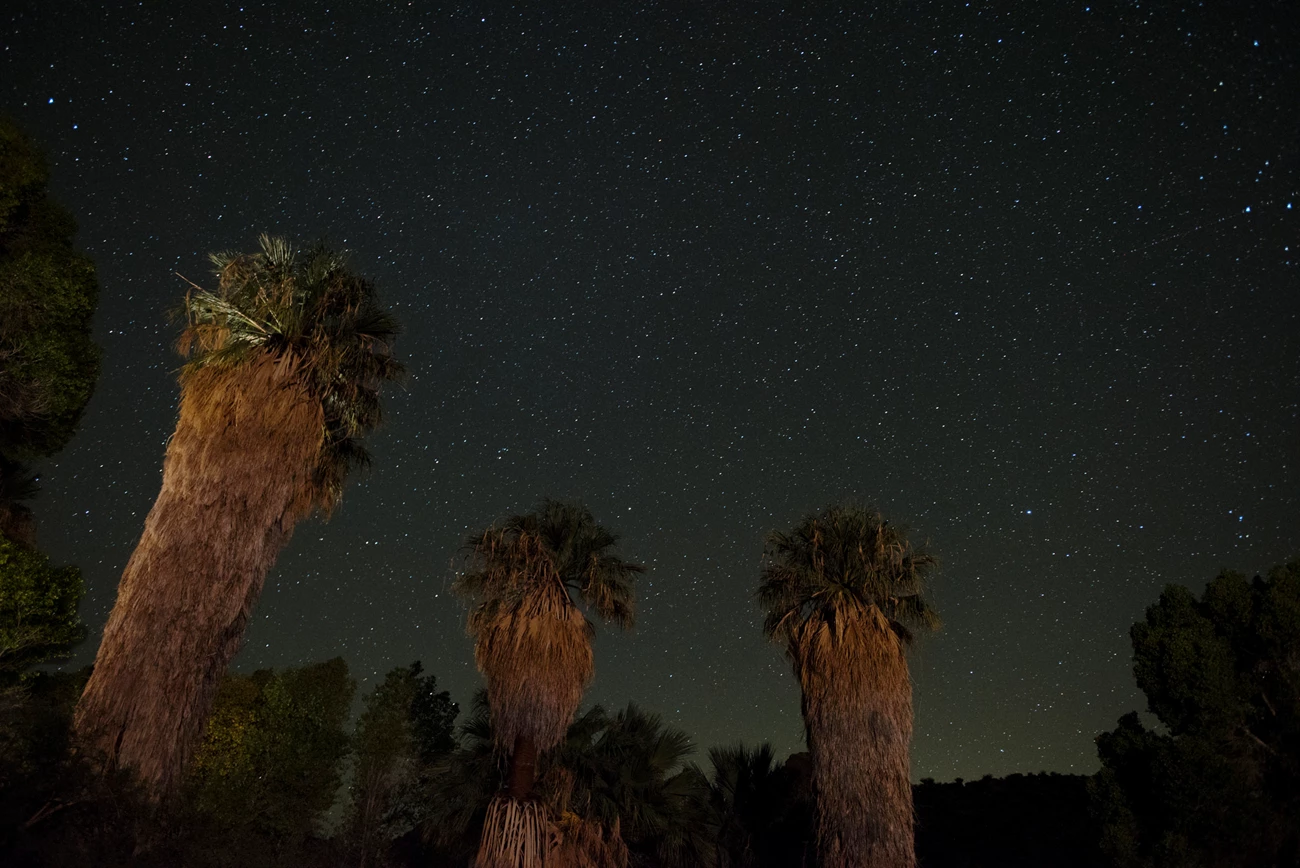
NPS / Hannah Schwalbe
This trail is located in the Colorado Desert portion of the park, in the scenic Eagle Mountains. From the trailhead, it is an easy downhill walk to Cottonwood Spring, where the palm oasis is located. Nearly one-half mile after Cottonwood Spring, the Mastodon Peak trail loops off from the Lost Palms Oasis trail. This section takes you through typical Sonoran Scrub vegetation, including unique stands of graythorn (Zizyphus obtusifolia) and Bigelow nolina (Nolina bigelovii). Once on the Mastodon Peak Loop trail, you will climb uphill along bouldery canyons and outcrops, with an optional detour to Mastodon Peak on an unmaintained trail. This loop is 2.4 miles (3.9 km) with moderate elevation gain.
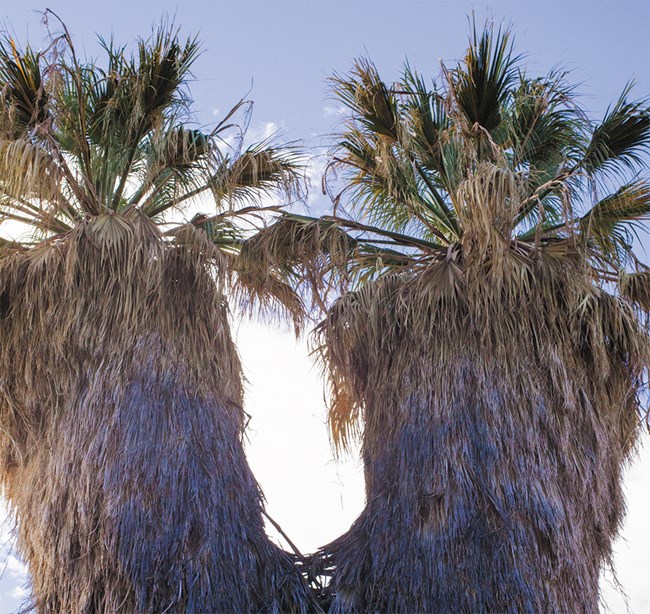
California Fan PalmWashingtonia filiferaFebruary–June One of the quintessential members of any oasis, these majestic trees indicate the presence of water. Remnants of a more subtropical time when forests of palms were widespread, you can now find them only in isolated areas that have permanent water sources. Palms may keep their dead leaves hanging for many years. The resulting petticoats or skirts of old fronds protect the trunk during fires and are home to many species of wildlife. 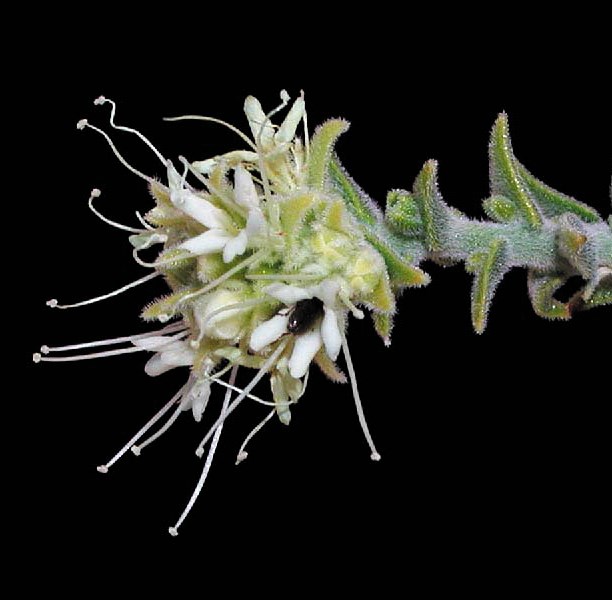
Sandpaper PlantPetalonyx thurberiMay–September Thurber was a botanist who collected many species during the Mexican boundary survey from 1850-1854. He sent his specimens to Asa Gray, the famous Harvard botanist, who named this species after him. Stiff, downturned hairs line the leaves of this plant, which gives it a texture like sandpaper. If you stick a leaf to your clothing, it will cling to you like Velcro! GraythornZiziphus obtusifoliaApril–June A large, spiny shrub, graythorn is restricted to the Colorado Desert region of the park; when you see this species, you know you are in a Sonoran Desert ecosystem. The northern geographic distribution of this genus is constrained by lack of summer rains and by potential frosts. The stems of this shrub are velvety and gray; they often appear to zigzag due to the right angles of the branching. 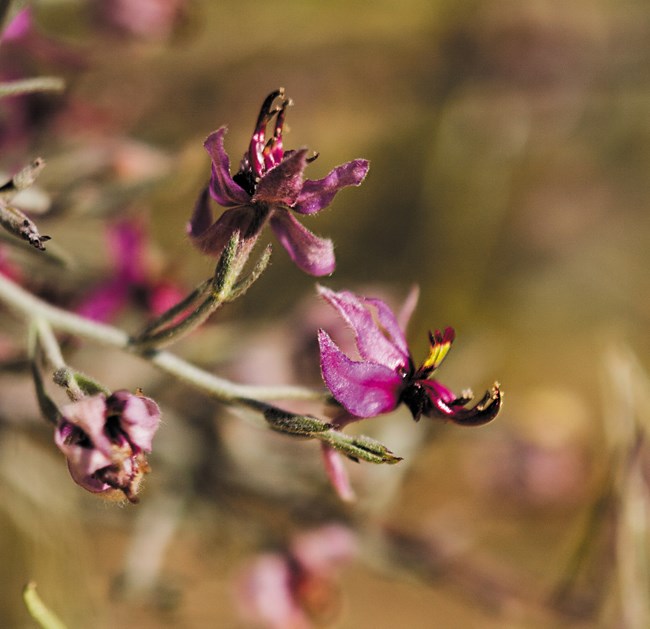
White RatanyKrameria bicolorApril–May Members of the genus Krameria are low-growing, densely-branched shrubs that parasitize the roots of neighboring woody plants. The striking flowers take an unusual form. The showy structures, which you might mistake for petals, are in fact bright magenta sepals bent backwards. The petals are highly modified: two of them act as oil glands and are only conspicuous if you are a bee. Bees combine this oil with pollen and feed it to their larvae. The best way to distinguish this species from the little-leaf ratany is to look at the barbs on the fruit: in white ratany, the barbs are all at the top in an umbrella-like whorl. 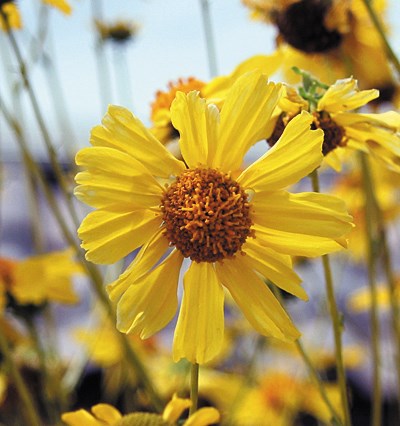
Mastodon Peak LoopBrittlebushEncelia farinosaJanuary–June This drought-deciduous shrub is common in open rock habitats below 3,300 feet (1,000 m). Brittlebush can dominate the most exposed and hottest of slopes. The leaves appear blue-green to white due to a dense covering of hairs. You can spot brittlebush best when it blooms; the flowering stalk is branched and contains multiple larger flowering heads, making it a very conspicuous part of the landscape. The stems on this woody shrub exude a bitter but fragrant resin, which helps protect it from hungry herbivores. 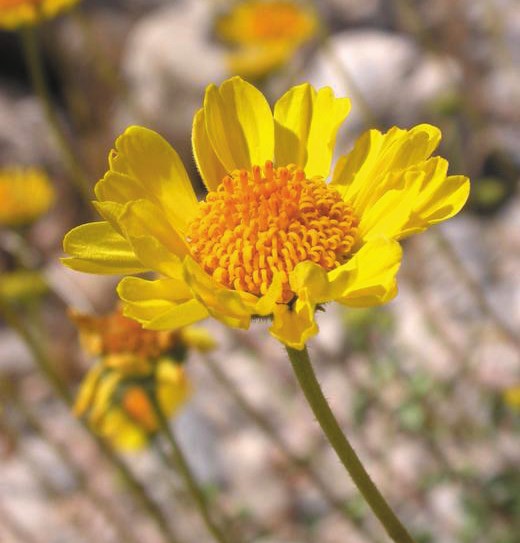
Acton's BrittlebushEncelia actoniFebruary–July Acton's Brittlebush and Brittlebush (abover) are two woody shrubs are common in open rocky habitats, especially on south-facing slopes. The best way to tell them apart is to look at the inflorescence: brittlebush has a branching inflorescence with multiple flowering heads, while Acton’s brittlebush has only one flowering head per stalk. The leaves of brittlebush are large and appear blue-green to white due to a dense covering of hairs on both surfaces. In contrast, Acton’s brittlebush has smaller, silvery-green leaves. The two species occupy different elevational gradients as well, and here in the park you will only find them together between elevations of 2,600–3,300 feet (800-1,000 m); Acton’s brittlebush prefers the higher elevations, whereas brittlebush prefers the lower. 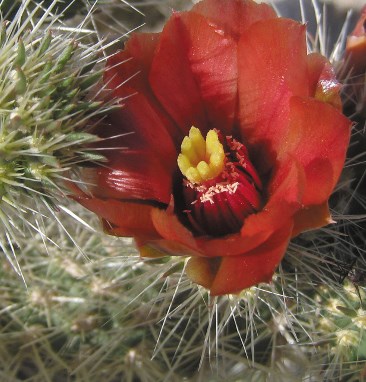
Chuckwalla ChollaCylindropuntia chuckwallensisMarch–April This cactus was recognized as being distinct from others and published as a new species to science in 2014. The fact that a new species can be described in such a widely travelled area highlights the need to protect and continue to explore the California desert. To distinguish from other cholla species, note that Chuckwalla cholla tends to be broader than tall, very densely branched, and with spines growing so thickly that it is difficult to see the stem beneath. Desert BrickelliaBrickellia desertorumSeptember–May A delicately branched shrub with inconspicuous white to light yellow flowering heads, you will find this species along narrow canyons growing near boulders and rocky outcrops. The small leaves resemble an arrowhead with toothed margins. Look closely for the small glands dotting many parts of the plant. Glands are usually a sign that a plant has chemical protections to prevent against herbivory, and they usually also mean the plant has a unique scent, another clue you can use in identification. Mouse-eyeBernardia incanaApril–May As with many species of the spurge family (Euphorbiaceae), this stiffly branched shrub is dioecious: you will find male and female flowers on separate individuals. On female plants you will find the typical three-parted fruit; it is thought that the common name derives from the pupil-like scar on each of these lobes. Mouse-eye is not common in the park, or along this trail; to distinguish it from other shrubs, look for the oval shaped leaves with scalloped edges. 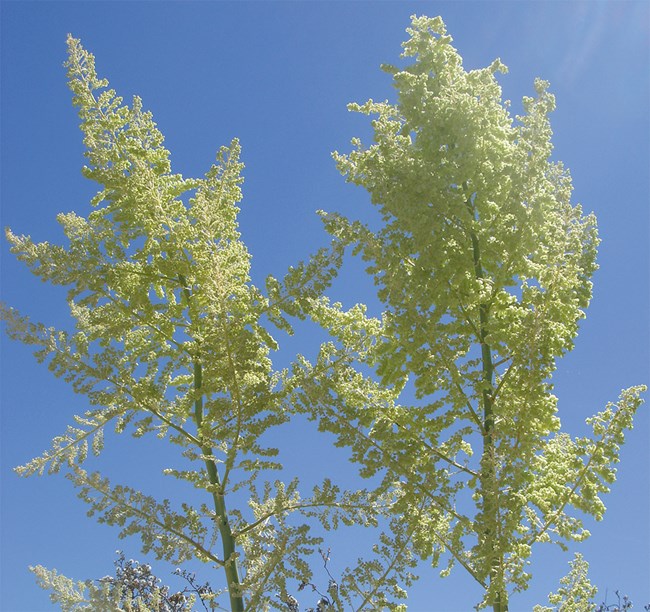
Bigelow NolinaNolina bigeloviiMay–June As with all Nolina, you can distinguish Bigelow nolina from Agave and Yucca by its long, flexible, sword-like leaves. You can further distinguish this species from all other Nolina by its fibrous-shredding leaf margins. This plant is one of many named for John M. Bigelow, M.D., who explored the area for the Pacific Railroad Survey in the mid 1800s. 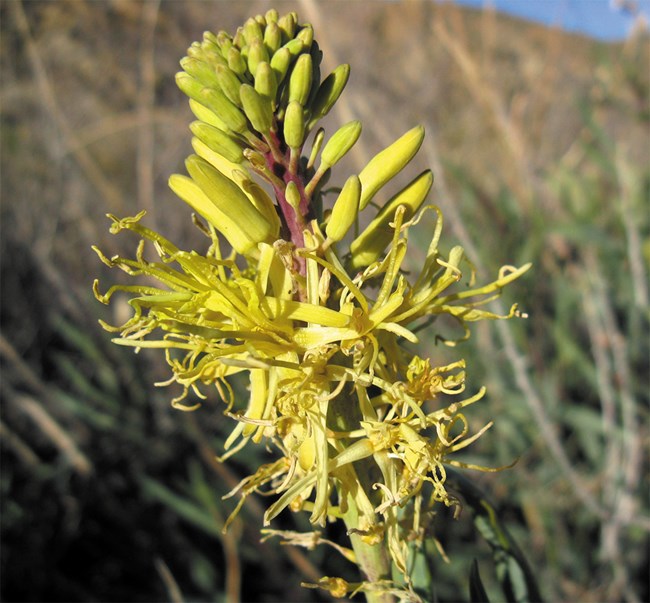
Prince's PlumeStanleya pinnataApril–September When in bloom, this plant is easy to spot: the tall flowering spikes of showy yellow flowers put on quite a display. Unlike many of its relatives, this member of the mustard family is not edible due to its ability to accumulate selenium. In fact, it is known as a selenium indicator because it is often abundant in places with high selenium content in the soil. The leaves and stems are toxic to any herbivore because selenium blocks the metabolism of calcium. 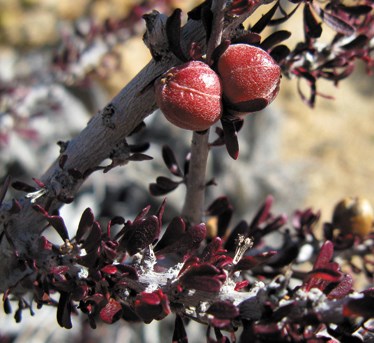
Purple BushTetracoccus halliiMarch–May Although this species is rare in California, it is the dominant species in a very small, localized area to the north of this trail. The colluvial plains to the west of Eagle Mountain contain the only known stand of Tetracoccus hallii shrubland that you will find in the park. This large, stiffly branched shrub is dioecious, meaning individual plants produce flowers with only male or female reproductive organs. The genus name (Tetracoccus) refers to the “four seeded” and finely tomentose (woolly) fruit. 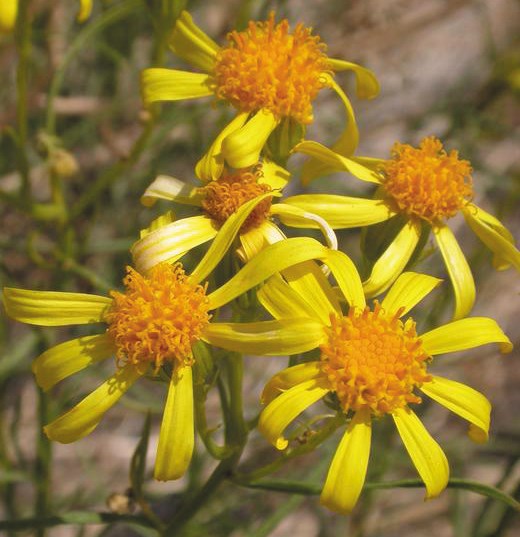
James Andre Threadleaf RagwortSenecio flaccidusJune–October Commonly found in washes, this shrubby species is very responsive to any type of moisture and you can often find it flowering throughout the year. The bright yellow flowering heads are a little more than an inch wide. Such striking blooms and often bright green foliage make the plant highly conspicuous. Many plants in the genus Senecio have pyrrolizidine alkaloids, which are toxic to both livestock and humans. Repeatedly digesting these plants has been known to cause liver cancer. 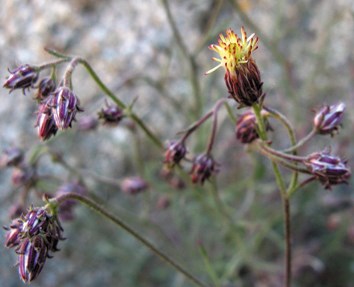
Bush ArrowleafPleurocoronis plurisetaOctober–June As the common name suggests, this small shrub has leaves that are shaped like tiny arrows, a unique trait that makes identification rather easy. You can find this small hardy shrub clinging to canyon walls and rock crevices. Despite these harsh conditions, it blooms in all but the hottest parts of the year. 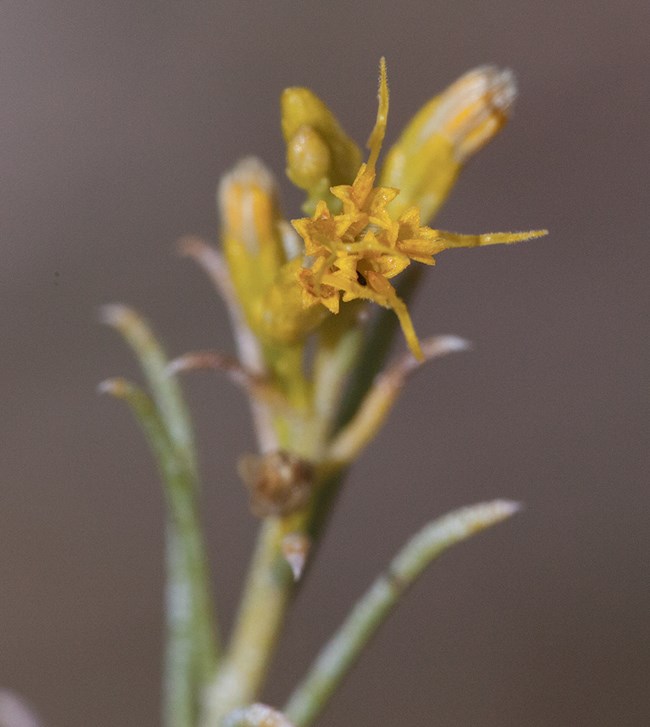
Black-banded RabbitbrushEricameria paniculataJune–December The common name of this rabbitbrush refers to the thick black bands along the stems caused by a smut fungus. You can see these bands from a distance, making it a distinguishing character of this species. In addition, it has distinct resinous dots on the leaves, visible as little depressions on the leaf surface. If the leaves seem discouragingly pungent, the resin is doing its job: it’s there to dissuade hungry herbivores. You can find the black-banded rabbitbrush along sandy wash corridors.
| ||||||||||||||||||||||||||||||||||||||||||||||||||||||||||||||||||||||||||||||||||||||||||||||||||||||||||||||||||||||||||||||||||||||||||||||||||||||||||||||||||||||||||||||||||||||||||||||||||||||||||||||||||||||||||||||||
Last updated: July 12, 2017
